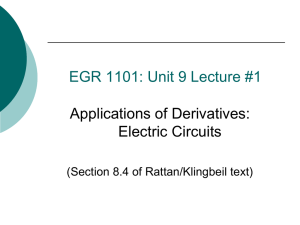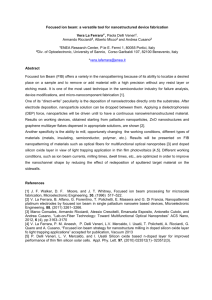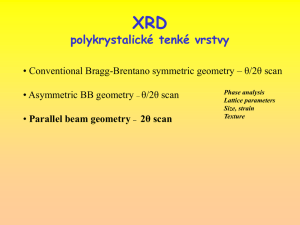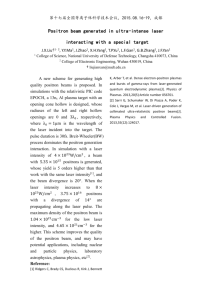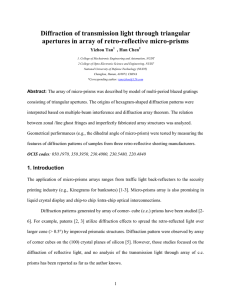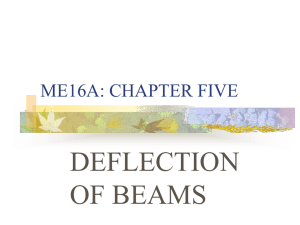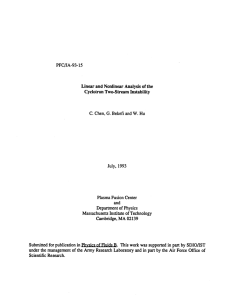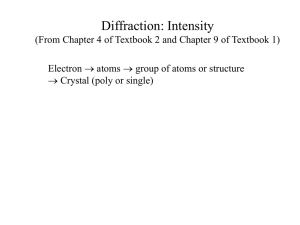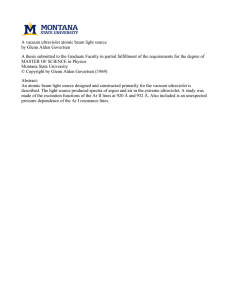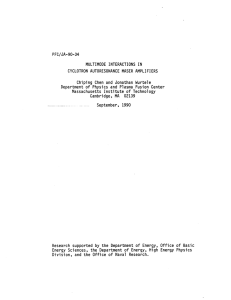Presentazione sulla Diffrazione Elettronica ad Area Selezionata (SAED)
advertisement
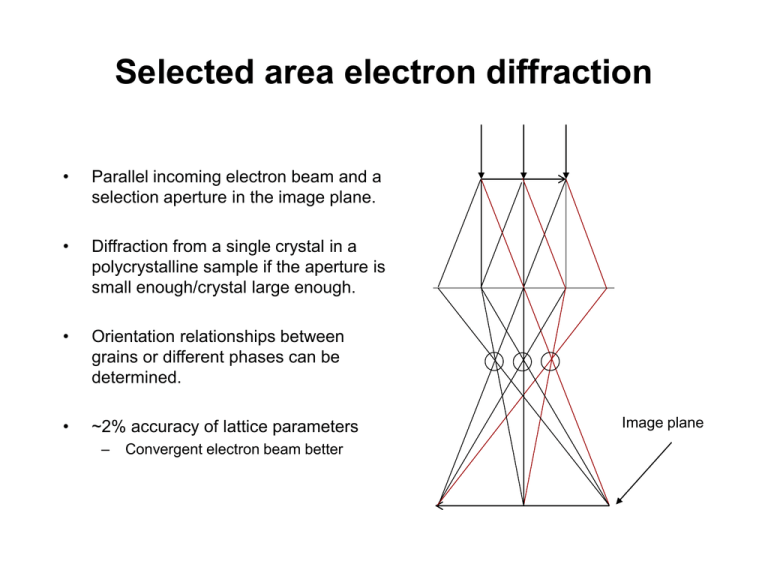
Selected area electron diffraction • Parallel incoming electron beam and a selection aperture in the image plane. • Diffraction from a single crystal in a polycrystalline sample if the aperture is small enough/crystal large enough. • Orientation relationships between grains or different phases can be determined. • ~2% accuracy of lattice parameters – Convergent electron beam better Image plane Diffraction with large SAD aperture, ring and spot patterns Poly crystalline sample Similar to XRD from polycrystalline samples. Four epitaxial phases The orientation relationship between the phases can be determined with ED. Higher order reflections, Laue zones 2d sinθ = nλ λ200kV = 0.00251 nm Θ~1o I(k’k)I=(2/λ)sinθ =g From one set Bof planes we only get one reflected beam -The Bragg angle increases with increasing order (n) -Tilt sample or beam to satisfy Bragg condition of higher order reflections. Ewald sphere (Reflecting sphere) The intensity distribution around each reciprocal lattice point is spread out in the form of spikes directed normal to the specimen 2θ k=1/λ First order Laue zone Zero order Laue zone (see figure 2.35 text book) Double diffraction, extinction thickness • Double electron diffraction leads to oscillations in the diffracted intensity with increasing thickness of the sample – – • Incident beam No double diffraction with XRD, kinematical intensities Forbidden reflection may be observed t0: Extinction thickness – – Periodicity of the oscillations t0=πVc/λIF(hkl)I Wedge shaped TEM sample t0 Transmitted Diffracted beam Doubly diffracted beam beam Kikuchi lines Deficient Used for determination of: -crystal orientation Excess θB θB -lattice parameter -accelerating voltage 2θB -Burgers vector Objective lens Diffraction plane Excess line Deficient line 1/d http://www.doitpoms.ac.uk/index.html http://www.doitpoms.ac.uk/tlplib/diffraction-patterns/kikuchi.php Camera constant R=L tan2θB ~ 2LsinθB 2dsinθB =λ ↓ R=Lλ/d Camera constant: K=λL Film plate Indexing diffraction patterns The g vector to a reflection is normal to the corresponding (h k l) plane and IgI=1/dnh nk nl (h2k2l2) - Measure Ri and the angles between the reflections - Calculate di , i=1,2,3 - Compare with tabulated/theoretical calculated d-values of possible phases - Compare Ri/Rj with tabulated values for cubic structure. - g1,hkl+ g2,hkl=g3,hkl (vector sum must be ok) - Perpendicular vectors: gi ● gj = 0 Orientations of corresponding planes in the real space (=K/Ri) Zone axis: gi x gj =[HKL]z All indexed g must satisfy: g ● [HKL]z=0 Example: Study of unknown phase in a BiFeO3 thin film Metal organic compound on Pt BiFeO3 Heat treatment at 350oC (10 min) to remove organic parts. Pt TiO2 Lim Process repeated three times before final heat treatment at 500-700 oC (20 min) . (intermetallic phase grown) SiO2 Bi Bi O O Si O Bi Bi Fe O Bi Fe Fe O O O O 200 nm Fe Bi Fe Fe Bi O Bi O O O Bi Bi Bi Fe Goal: Fe Fe O O O O BiFeO3 with space grupe: R3C and celle dimentions: a= 5.588 Å c=13.867 Å c b a O Fe Bi Fe Bi Bi O Fe Bi Bi Po wd erCell 2 .0 Determination of the Bravais-lattice of an unknown crystalline phase Tilting series around common axis 27o 15o 50 nm 10o 0o Determination of the Bravais-lattice of an unknown crystalline phase Tilting series around a dens row of reflections in the reciprocal space 0o 50 nm 19o Positions of the reflections in the reciprocal space 25o 40o 52o Bravais-lattice and cell parameters 011 111 001 c 101 b 010 a 110 100 [011] [100] [101] d=Lλ/R 6.04 Å From the tilt series we find that the unknown phase has a primitive orthorhombic Bravias-lattice with cell parameters: a= 6,04 Å, b= 7.94 Å og c=8.66 Å 7.94 Å α= β= γ= 90o Chemical analysis by use of EDS and EELS Ukjent fase BiFe2O5 BiFeO3 CCD counts x 1000 CCD counts x 1000 1_1evprc.PICT Nr_2_1evprc.PICT 40 14 35 12 O-K Fe - L2,3 30 10 25 8 20 6 BiFeO3 Ukjent fase 4 15 2 10 -0 5 500 1 eV pr.600 kanal 800 -0 eV forskyvning, 200 400 -0 200 Energy (eV) 400 Loss 600 Energy Loss (eV) 800 1000 1000 Published structure A.G. Tutov og V.N. Markin The x-ray structural analysis of the antiferromagnetic Bi2Fe4O9 and the isotypical combinations Bi2Ga4O9 and Bi2Al4O9 Izvestiya Akademii Nauk SSSR, Neorganicheskie Materialy (1970), 6, 2014-2017. Romgruppe: Pbam nr. 55, celleparametre: 7,94 Å, 8,44 Å, 6.01Å Bi O Bi O Bi Fe Fe O O O O 4g 4h 4f 4g 8i 4h 2b x 0,176 0,349 0 0,14 0,385 0,133 0 y 0,175 0,333 0,5 0,435 0,207 0,427 0 O Bi z 0 0,5 0,244 0 0,242 0,5 0,5 O Bi Fe O O Fe Fe O O Fe O O Fe O O Fe O Fe O O Fe O Fe O O O Fe Fe O O Fe Bi O Bi O O Bi O Bi c b Po wd erCell 2 .0 a Celle parameters found with electron diffraction (a= 6,04 Å, b= 7.94 Å and c=8.66 Å) fits reasonably well with the previously published data for the Bi2Fe4O9 phase. The disagreement in the c-axis may be due to the fact that we have been studying a thin film grown on a crystalline substrate and is not a bulk sample. The conditions for reflections from the space group Pbam is in agreement with observations done with electron diffraction. Conclusion: The unknown phase has been identified as Bi2Fe4O9 with space group Pbam with cell parameters a= 6,04 Å, b= 7.94 Å and c=8.66 Å.
